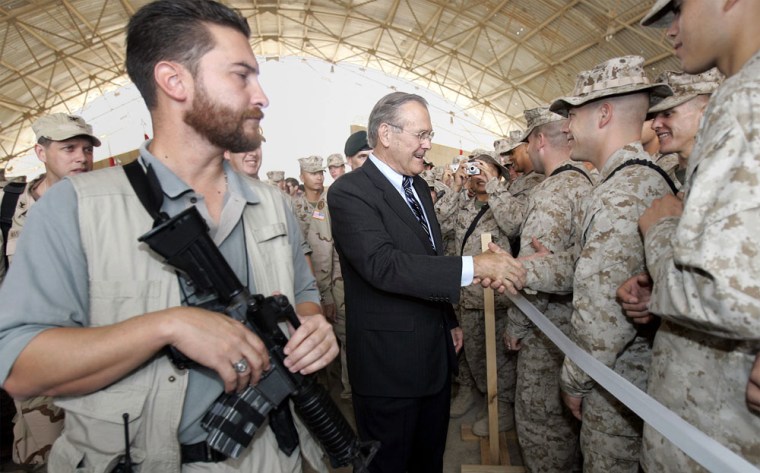The United States may be able to reduce its troop levels in Iraq after this country’s January elections if security improves and local forces continue to expand and become more effective, Defense Secretary Donald H. Rumsfeld says.
In a question-and-answer session Sunday with hundreds of Marines assembled in a concrete-lined hangar at this desert base in western Iraq, Rumsfeld was asked what the future holds for the length and frequency of troop deployments in the country.
Rumsfeld, on his first visit to Iraq since its interim government was installed in June, said the insurgent violence is likely to get worse in the weeks ahead, so troop reductions are almost out of the question. The United States now has about 135,000 troops in Iraq.
“Our hope is that as we build up Iraqi forces, we will be able to relieve the stress on our forces and see a reduction in coalition forces over some period of time, probably post-Iraqi elections,” the Pentagon chief said. “But again, it will depend entirely on the security situation here in this country.”
Later, Rumsfeld flew to the northern city of Kirkuk, where he received a briefing from the top commander in that area, Maj. Gen. John Batiste, and other American officers, who told him that insurgent attacks had decreased since July. They also said U.S.-trained Iraqi forces in the Kirkuk area were improving so quickly that they recently were able to plan and execute offensive operations on their own, with U.S. officers present only as observers.
Rumsfeld had dinner with South Korean soldiers who began arriving in Iraq last month to provide combat and support forces around the city of Irbil, west of Kirkuk.
Limited Q&A
Before Rumsfeld appeared at the main operating base of the 3rd Marine Air Wing, the approximately 1,500 Marines in his audience were given instructions by Sgt. Maj. Dennis Reed on what not to ask. “Don’t ask when you’re going home,” he said. “We’ll tell you when you’re going home.”
Rumsfeld afterward gave a pep talk and fielded questions at a town hall-style meeting. “We’re so fortunate to be able to count on you in this time of peril,” he said to applause.
The secretary then flew to Baghdad and met with U.S. Ambassador John Negroponte, Gen. George Casey, the top American commander in Iraq; and Lt. Gen. David Petraeus, who is in charge of training and equipping Iraqi security forces.
Accompanying Rumsfeld on the flight in a Black Hawk helicopter was Hazem Shaalan, Iraq’s interim defense minister.
As a reminder of the tenuous security situation in the Iraq capital, the helicopters carrying Rumsfeld and his entourage flew at high speed, just above rooftop level, occasionally zigzagging en route to the International Zone where the U.S. Embassy is located.
In a brief exchange with reporters after the Baghdad meeting, Rumsfeld grew agitated by questions about the possibility of needing to bring in more American troops before Iraq’s scheduled elections.
“There’s a fixation on that subject!” he said with exasperation. “It’s fascinating how everyone is locked on that.”
Rumsfeld: Progress training Iraqis
He asserted that the news media and others are ignoring the fact that the number of U.S.-trained Iraqi security forces is growing — standing now at about 100,000 — and that they are fighting and dying.
“They do exist. Over 700 of them have been killed,” Rumsfeld said.
Casey told reporters that he and Rumsfeld did not discuss U.S. troops levels in their meeting.
“If I need more troops, as the secretary said, I will ask for them,” Casey said. He added that trained Iraqi forces will increase by 45,000 by the January election.
Rumsfeld also met with Ayad Allawi, the interim Iraqi prime minister, at the government’s headquarters not far from the U.S. Embassy.
The trip was Rumsfeld’s sixth to Iraq but his first to Anbar province, which includes portions of the Sunni Triangle north and west of Baghdad. The region had been the heart of tribal support for deposed President Saddam Hussein.
In light of the violence in Iraq, Rumsfeld’s visit was not announced in advance. Reporters traveling with the secretary were instructed not to disclose his plans until he arrived in Iraq from Bahrain aboard an Air Force C-17 cargo plane.
Later this week, Rumsfeld attends a meeting of NATO defense ministers in Romania. Expected to be on the agenda Wednesday and Thursday are issues such as the alliance’s role in Afghanistan, where it commands the International Security Assistance Force, and Iraq, where it has agreed to help train Iraqi security forces.
